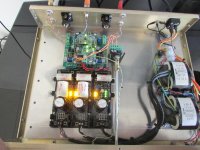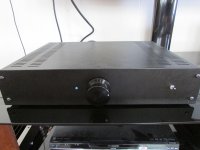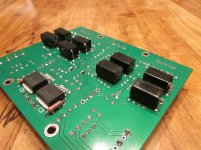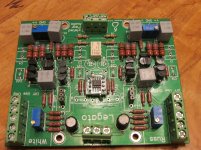Hello William,
interesting to hear this because i tried some of it as well. I believe what made most of the change in your case is replacing decoupling caps with 1837, since that's where i heard significant difference as well. However - maybe with Salas it's different, but with Placid to my ear - while soundstage and highs got more smooth and impressive just like you said - the tonal balance changed to more "thin" and everything lower lost a bit of "meat" and dynamics. I don't know if it's just difference in signature of caps, or 0.1uF is simply not enough for good decoupling there since it obviously doesn't work at lower frequencies... So far i use Panasonic FM bypassed by 1837 as compromise in those positions. Maybe it's worth to try 1837 only again one day, just not sure if it's good from technical point of view..
But I'll try other mods you described, thanks for sharing 🙂
interesting to hear this because i tried some of it as well. I believe what made most of the change in your case is replacing decoupling caps with 1837, since that's where i heard significant difference as well. However - maybe with Salas it's different, but with Placid to my ear - while soundstage and highs got more smooth and impressive just like you said - the tonal balance changed to more "thin" and everything lower lost a bit of "meat" and dynamics. I don't know if it's just difference in signature of caps, or 0.1uF is simply not enough for good decoupling there since it obviously doesn't work at lower frequencies... So far i use Panasonic FM bypassed by 1837 as compromise in those positions. Maybe it's worth to try 1837 only again one day, just not sure if it's good from technical point of view..
But I'll try other mods you described, thanks for sharing 🙂
Last edited:
I don't believe the tonal balance changed for the worse as you noted. It's definitely more open and transparent sounding, but did not notice losing anything. It needs more run-in time though so we will see how it is after everything settles in.
Actually I liked it too, but since change in sound was more evident than between changing different electrolytic types I wasn't sure if it's improvement, or we improve and boost highs (and that's why it's more transparent and open) at expense of lower frequencies which now have to get their current through longer PCB traces from PSU directly if I got it right... Because there is a change between HF and LF balance I hear for sure.
In theory - our shunt PSUs are excellent source of current on their own, possibly better than lytic capacitor, if it wasn't for those pcb traces...
Anyway - since I still have test sockets on my legato in place of decoupling caps i'll try it again, and i'll try polystyrene caps in filtering, thanks for the idea!
In theory - our shunt PSUs are excellent source of current on their own, possibly better than lytic capacitor, if it wasn't for those pcb traces...
Anyway - since I still have test sockets on my legato in place of decoupling caps i'll try it again, and i'll try polystyrene caps in filtering, thanks for the idea!
I have run my L3 with Salas Shunts and .1 uF 1837s (no bigger caps) in place of the 100 uFs for a long time now, and experience no loss of "weight", "meat", or bass. The Salas Shunts do not like to see lots of C at their outputs, but note that if one does this with TPA Placids they are likely to oscillate and sound terrible, I am pretty sure Russ designed the Placids' compensation such that they want to see the bigger decoupling caps at the load.
I am also running REL RTE polystyrenes for the filter/comp caps.
I am also running REL RTE polystyrenes for the filter/comp caps.
Hello Barrows, I read your topics on TPA forum and actually it's because of them I tried 0.1 films in decoupling positions. And I remember that your Legato wasn't oscillating, but Ivy did? And Russ said it's about Placid compensation and can be changed ... Never got to it yet though, but encountered oscillation when powered WaveIO by Placid - fixed by adding small (1837 actually) cap in parallel though...
So, I installed 1837 in most sensitive position (which is C15/C16 on Legato) in one channel and I must say that subjectively I do hear improvement in transparency and resolution compared to other channel with PanaFM in it. Highs are cleaner and transparent and bass actually more powerfull on some notes, goes even deeper... I guess i'll stick to 1837 for a while too 😀 I also wanted to try OSCON SP in that position, now it's the time to see how it will fare against 1837...
So, I installed 1837 in most sensitive position (which is C15/C16 on Legato) in one channel and I must say that subjectively I do hear improvement in transparency and resolution compared to other channel with PanaFM in it. Highs are cleaner and transparent and bass actually more powerfull on some notes, goes even deeper... I guess i'll stick to 1837 for a while too 😀 I also wanted to try OSCON SP in that position, now it's the time to see how it will fare against 1837...
Last edited:
Many thanks for the photos, William, and also for the source of the exact parts. I've listened to my new L3.1s now for a few days and will put polystyrenes in. I had RelCap polystyrenes in my retired L2.0 and as best I remember it, the sound had significantly better spatial detail. [However, my A/B test situation is very poor - long delay, new house, much bigger room...] I use longer pins and standoffs between B3 and L3, so I hope I can fit (at least most of) them on top...
A quick comment about Alexander's observation of less 'meat' and loss of dynamics... Of course, suit yourself! To me, hearing a bit less of a recording's main component does not necessarily mean a loss of fidelity. In cases I have witnessed, such 'loss' came with significant increases in fidelity. Every system and setting will differ, of course, and some program material will be more revealing than others. So I suggest you compare/contrast the difference using a good recording of choral vocals. Like them or not, chorals are even more revealing than well-recorded string sections, IMO. Of course it takes time for the brain to wrap around these kinds of changes - but I like to hear 'everything more' rather than 'a few things better'. 😀
Cheers,
Frank
A quick comment about Alexander's observation of less 'meat' and loss of dynamics... Of course, suit yourself! To me, hearing a bit less of a recording's main component does not necessarily mean a loss of fidelity. In cases I have witnessed, such 'loss' came with significant increases in fidelity. Every system and setting will differ, of course, and some program material will be more revealing than others. So I suggest you compare/contrast the difference using a good recording of choral vocals. Like them or not, chorals are even more revealing than well-recorded string sections, IMO. Of course it takes time for the brain to wrap around these kinds of changes - but I like to hear 'everything more' rather than 'a few things better'. 😀
Cheers,
Frank
I just finished trying various capacitors some more and my conclusion - all is good except replacement of decoupling caps. If powered by single Placid 2.1 - reducing caps from 100uF to 0.1uF actually makes it all worse, including dynamics, but the most obvious effect is the loss of lower bass - there's simply less of it so all mid-high details stand out and that's where impression of more transparency and detail is coming from. What you get is actually less smooth, more "shouty" and "pale". You get similar sound if using very small value electrolytics .So i think proper decoupling is important.. No oscillation in any case btw.
All this with Placid BP 2.1 so maybe it's different with Salas.
My test system was buffalo IIIse > Pass F5 > TroelsG. DTQWT speakers
As a side note: I also tried different electrolytes in decoupling positions, including elna silmic II, BlackGate-PK, Nichicon KZ of same value\voltage to see how esr/inductance/dissipation affect these positions - and despite all my audiphilic hopes - i found panasonic FM works the best. If most colorless/precise sound is the goal of course.
The only truly 100% worthy replacement i ever had with full Buffalo3 dac is getting Mundorf AG power caps in my Placids, but again - those have remarkable low ESR/ESL/tan...
francolargo: "loss" and "fidelity" are kind of opposite, don't you think? What i do believe is that when you hear more = more resolution and dynamics, you also hear more noise/distortions etc. of your system so you either "blur" it with some components, or continue to pursue ultimate purity of reproduction which allow you to hear full detail and dynamics while musical and enjoyable. The hardest way in audio imo. But I think Buffalo DAC is the product born from such a goal as is most TPA stuff...
All this with Placid BP 2.1 so maybe it's different with Salas.
My test system was buffalo IIIse > Pass F5 > TroelsG. DTQWT speakers
As a side note: I also tried different electrolytes in decoupling positions, including elna silmic II, BlackGate-PK, Nichicon KZ of same value\voltage to see how esr/inductance/dissipation affect these positions - and despite all my audiphilic hopes - i found panasonic FM works the best. If most colorless/precise sound is the goal of course.
The only truly 100% worthy replacement i ever had with full Buffalo3 dac is getting Mundorf AG power caps in my Placids, but again - those have remarkable low ESR/ESL/tan...
francolargo: "loss" and "fidelity" are kind of opposite, don't you think? What i do believe is that when you hear more = more resolution and dynamics, you also hear more noise/distortions etc. of your system so you either "blur" it with some components, or continue to pursue ultimate purity of reproduction which allow you to hear full detail and dynamics while musical and enjoyable. The hardest way in audio imo. But I think Buffalo DAC is the product born from such a goal as is most TPA stuff...
Last edited:
I think...
You might have misunderstood my findings? I reported that the Placid HD would become unstable (not the L-III) if one reduced the L-III decoupling caps to .1 µF, this is likely the cause of your sonic problems using .1 µF decoupling with the Placid HD. Russ has noted that the Placid HD is compensated such to expect higher value caps at the load.
On the other hand, when using Salas Shunts (BiB), the L-III decoupling needs to be reduced to .1µF as the Salas Shunts do not like to see lots of C on their outputs.
I just finished trying various capacitors some more and my conclusion - all is good except replacement of decoupling caps. If powered by single Placid 2.1 - reducing caps from 100uF to 0.1uF actually makes it all worse, including dynamics, but the most obvious effect is the loss of lower bass - there's simply less of it so all mid-high details stand out and that's where impression of more transparency and detail is coming from. What you get is actually less smooth, more "shouty" and "pale". You get similar sound if using very small value electrolytics .So i think proper decoupling is important.. No oscillation in any case btw.
All this with Placid BP 2.1 so maybe it's different with Salas.
My test system was buffalo IIIse > Pass F5 > TroelsG. DTQWT speakers
As a side note: I also tried different electrolytes in decoupling positions, including elna silmic II, BlackGate-PK, Nichicon KZ of same value\voltage to see how esr/inductance/dissipation affect these positions - and despite all my audiphilic hopes - i found panasonic FM works the best. If most colorless/precise sound is the goal of course.
The only truly 100% worthy replacement i ever had with full Buffalo3 dac is getting Mundorf AG power caps in my Placids, but again - those have remarkable low ESR/ESL/tan...
francolargo: "loss" and "fidelity" are kind of opposite, don't you think? What i do believe is that when you hear more = more resolution and dynamics, you also hear more noise/distortions etc. of your system so you either "blur" it with some components, or continue to pursue ultimate purity of reproduction which allow you to hear full detail and dynamics while musical and enjoyable. The hardest way in audio imo. But I think Buffalo DAC is the product born from such a goal as is most TPA stuff...
You might have misunderstood my findings? I reported that the Placid HD would become unstable (not the L-III) if one reduced the L-III decoupling caps to .1 µF, this is likely the cause of your sonic problems using .1 µF decoupling with the Placid HD. Russ has noted that the Placid HD is compensated such to expect higher value caps at the load.
On the other hand, when using Salas Shunts (BiB), the L-III decoupling needs to be reduced to .1µF as the Salas Shunts do not like to see lots of C on their outputs.
Yes, i understood that and checked Placids with the scope. I forgot to mention though that i never touched the 100uF decoupling close to the buffers because i believe they are a must, maybe that was enough to keep Placids stable.You might have misunderstood my findings? I reported that the Placid HD would become unstable (not the L-III) if one reduced the L-III decoupling caps to .1 µF, this is likely the cause of your sonic problems using .1 µF decoupling with the Placid HD.
Anyway - my point is that reducing most of decoupling caps to 0.1 with placid 2.1 didn't work well, even though i measured no problems. But other mods described earlier did make a difference, although smaller and i'm yet to decide on them
Last edited:
Thanks, guys, for the additional clarifications... As I'm powering my boards with Placids, my plan is to parallel the panasonic decoupling caps with 1837s tacked underneath - the same as augmenting large electrolytics with smaller film caps in an amp power supply. Perhaps we should also state our respective shunt currents? Mine are 85-90 mA. I have both Placid HDBP versions 2.0 and 2.1 and appreciate the significant upgrade from the earlier to the current version!
My comments about distortion were principally directed toward those arising in loudspeakers and due to imperfect room acoustics - if that makes more sense...
My comments about distortion were principally directed toward those arising in loudspeakers and due to imperfect room acoustics - if that makes more sense...
I tried bypassing decoupling caps with 0.1 films - there was a similar slight change, but with no obvious shortcomings in bass/dynamics i mentioned earlier. But since i don't have a way to measure caps for resonances yet i decided not to mess with it for now.As I'm powering my boards with Placids, my plan is to parallel the panasonic decoupling caps with 1837s tacked underneath - the same as augmenting large electrolytics with smaller film caps in an amp power supply.
But you can try it and see for yourself - it's the easiest mod possible, just solder films to electrolyte's legs from the other side to one channel and compare.
I'm shunting about 80mA +assymetric voltage output (30mV higher voltage on - line). Honestly - i didn't hear much change from shunting more/less past 50-60mA.. Did you?
Last edited:
I tried bypassing decoupling caps with 0.1 films - there was a similar slight change, but with no obvious shortcomings in bass/dynamics i mentioned earlier. But since i don't have a way to measure caps for resonances yet i decided not to mess with it for now.
Good thought... I just looked up the intrinsic MKP 1837 resonant frequency and it looks like +/- 6.5 MHz for 0.1 uf. I haven't found specific data for the Panasonic FM version, but general design guidelines suggest it is no higher than 1MHz and very broad. So I don't expect any trouble and my goal in adding the 1837s is simply to increase slew rate.
Question: When you were testing the 330 uf Panasonics, in which positions did you place them (C9-C16)? ...on one stereo pair I'm looking to eek out the very last drop of bass extension and damping, plus there is a bit of supply 'wiggle' from the Placid 2.0 on that Legato.
I'm shunting about 80mA +assymetric voltage output (30mV higher voltage on - line). Honestly - i didn't hear much change from shunting more/less past 50-60mA.. Did you?
Until some other equipment upgrades are done, I'm running what i liked with the L2: +15v, -13.5v, and a little over 70mA shunted. On this new build I have silent, isolated active heat extraction over the three placids. So even shunting over 100 mA runs cooler than 70 mV with open-top convection. But with B2+L2 I didn't hear any benefit beyond ~70mA...
Photo: 12v 5" fluid bearing fans mounted over grounded screens - with 9v switching supply, start/stop relay and a bit of speed control...
Attachments
C9,C10,C13,C14... You think larger than 100uF decoupling caps could be beneficial? Recently i tried 220uF BG-PK at C15/C16 and had the impression that bass got a bit stronger and more "firm", i thought it just BG's coloration but could be from increased capacitance? There's another trick i found easy and somewhat audible - paralleling 2 identical electrolytes (adding similar one at at other side of PCB) like 100+100..Question: When you were testing the 330 uf Panasonics, in which positions did you place them (C9-C16)? ...on one stereo pair I'm looking to eek out the very last drop of bass extension and damping, plus there is a bit of supply 'wiggle' from the Placid 2.0 on that Legato.
Last edited:
C9,C10,C13,C14... You think larger than 100uF decoupling caps could be beneficial? Recently i tried 220uF BG-PK at C15/C16 and had the impression that bass got a bit stronger and more "firm", i thought it just BG's coloration but could be from increased capacitance? There's another trick i found easy and somewhat audible - paralleling 2 identical electrolytes (adding similar one at at other side of PCB) like 100+100..
I have 220uf Panasonic FMs coming, with the idea of beefing up C9,10,13,14 on the bass board. On that one I also plan to test whether there is any audible benefit of 220 uf at C15&16, both with and without a MKP 1837 bypass. ...might use all of that 90mA shunt overhead after all? 😛
I thought 100uF is a lot already, but - let us know if you got any improvements! I still have quick connects soldered so i can swap caps quickly - i'll try it too, not sure if i'll be able to hear a lot of difference, but we'll see 🙂I have 220uf Panasonic FMs coming, with the idea of beefing up C9,10,13,14 on the bass board. On that one I also plan to test whether there is any audible benefit of 220 uf at C15&16, both with and without a MKP 1837 bypass. ...might use all of that 90mA shunt overhead after all? 😛
Why's that? I can't find schematics on their sites...only some comparisons to the stuff Placids will likely eat for breakfast...Trow away the Placids and buy Teddy Pardo or Belleson
- Home
- More Vendors...
- Twisted Pear
- Legato 3 - Look ma! No caps!




